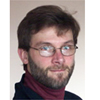
Robert Insall
Robert Insall has been studying Cell Migration, in one form or another, for the last 15 years. He studied Natural Science at Cambridge University, migrating from chemistry towards molecular biology during the degree, then remained in Cambridge to do a Ph.D. with Dr. Rob Kay investigating intercellular signalling pattern formation in developing Dictyostelium. During this time he became fascinated in chemotaxis, the process by which Dictyostelium cells aggregate together by moving towards cAMP signals secreted by their neighbours. He therefore moved to the Johns Hopkins Hospital in Baltimore, USA, for postdoctoral work with Professor Peter Devreotes, where he cloned CRAC (the first PH-domain-containing protein found to localise to the leading edge during chemotaxis) and identified a role for RasGEFs during chemotaxis. He started his own group in University College London in 1995, followed by a move to Birmingham University in 1999 and more recently to the Beatson Institute for Cancer Research in Glasgow, Scotland. Areas of current interest include the genetics of the Arp2/3 complex and the proteins that activate it, and quantitative analysis and modelling of chemotaxis and cell migration. Much of this work still uses Dictyostelium, but his work also covers human neutrophils and cancer cells, the pathogen Entamoeba histolytica, and any eukaryotic cells whose physiology depends on cell migration.
 |
|
|
|
|
|

